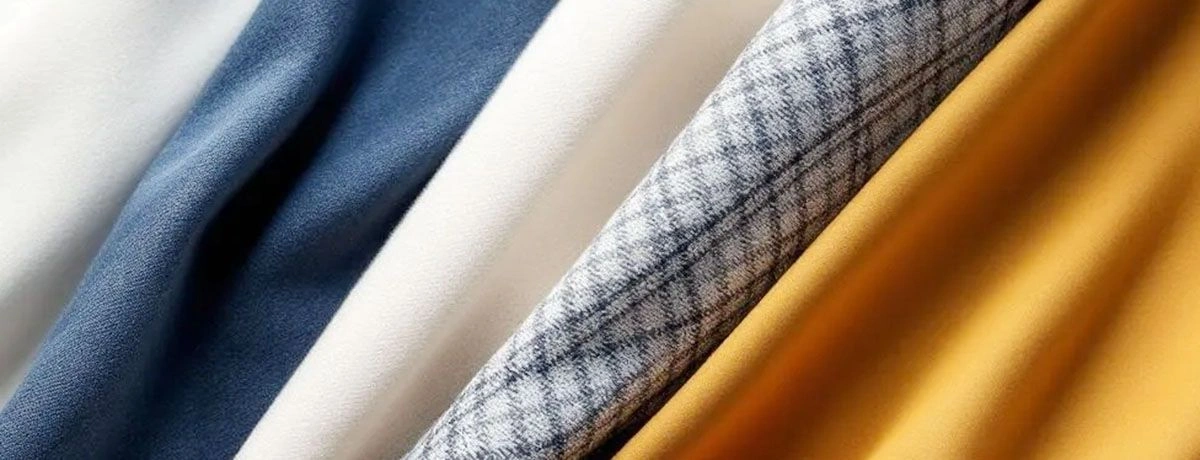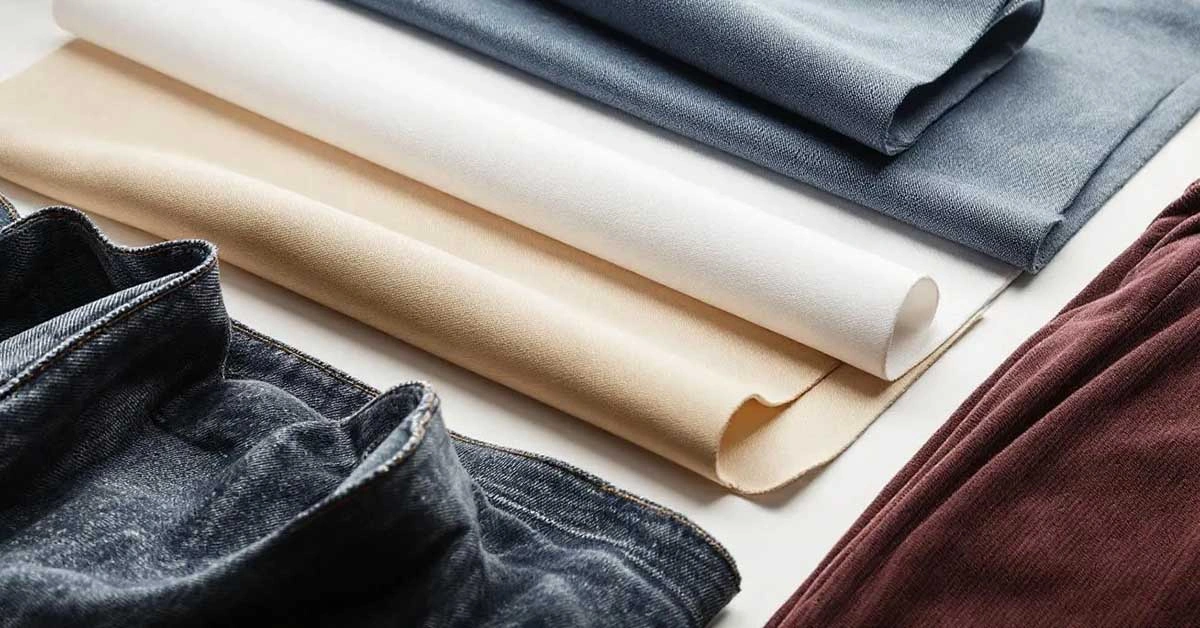Best Trouser Fabric Choices for Durability and Style

Choosing the right trouser fabric ensures comfort, durability, and style. This article covers the best fabrics for different types of trousers, discussing their benefits and care tips. Read on to make well-informed choices for your wardrobe.
Key Takeaways
-
Choosing durable trouser fabrics involves considering elasticity, wrinkle resistance, and maintenance for longevity.
-
Different fabric types like cotton twill, linen blends, wool suiting, denim, and corduroy offer unique advantages suited for various occasions.
-
Understanding fabric weights (light, medium, heavy) is crucial for selecting trousers that fit the desired style and climate.
Essential Characteristics of Trouser Fabrics
Durability is a crucial factor when choosing trouser fabrics. High-quality materials should endure regular use while retaining their shape and appearance, ensuring your trousers look great and last longer, offering better value for money. Elasticity also contributes to comfort, enabling better movement throughout the day. Fabrics with some stretch, like those with elastane, are especially useful for daily wear.
Wrinkle resistance is another valuable feature, reducing the need for frequent ironing and making the high quality fabric more practical for everyday use. High-quality wrinkle resistant fabrics typically combine these traits, providing durability, comfort, and ease of maintenance.
Whether you’re looking for casual trousers or formal wear, understanding these characteristics can help you choose the best fabric for your needs.
These same qualities—durability, elasticity, and wrinkle resistance—are also highly valued in shirts, especially for active wear, where strength and easy maintenance are just as important.
Types of Trouser Fabrics

Trouser fabrics come in a variety of types, each with its own set of benefits and ideal uses. There is a wide range of colors and fabric types available for trousers, offering diverse options for customization and style to suit any preference:
-
Cotton twill
-
Linen blends
-
Wool suiting
-
Denim
Each fabric type offers unique advantages such as comfort, durability, stretch, drape, and material canvas textures, making them suitable for different occasions and styles. The fabric is often stretched to enhance its appearance and fit.
Here are some of the most popular fabrics used in trousers.
Cotton Twill
Cotton twill is a cotton fabric renowned for its durability and strength, thanks to its diagonal woven pattern. This unique weave makes it less prone to wrinkling and easier to maintain compared to other fabrics. Cotton twill is commonly used in making sturdy pants and trousers, making it a popular choice for both casual and workwear.
This versatile fabric also conceals dirt and retains warmth, making it ideal for practical applications like denim jeans, chinos, and garment care. Its ease of care, whether via machine or hand washing, further enhances its appeal for everyday use.
Brown is a classic color choice for cotton twill chinos, often associated with vintage styles and known for the durability and high quality of older, brown stock trousers.
Linen Blends
Linen blends combine the breathability and comfort of linen with the reduced wrinkling of other fibers, making them perfect for summer trousers. Lightweight and breathable, these fabrics keep the wearer cool and comfortable in hot weather, making them ideal for summer styles.
Cream is a popular color for linen/cotton blend trousers, offering a light and sophisticated look that is especially suitable for summer.
Linen blends also minimize wrinkles compared to pure linen, reducing the need for frequent ironing and enhancing convenience. Available in various weights, these blends offer versatility in design and application.
Wool Suiting
Wool suiting fabrics are highly regarded for their warmth, durability, and suitability for both formal and casual trousers. Wool naturally repels water due to the lanolin it contains, offering some protection against moisture and making it an excellent choice for different weather conditions.
Wool blend fabrics, which combine wool with fibers such as polyester, viscose, or lycra, offer enhanced wrinkle resistance, comfort, and stretch. These blends are versatile and provide improved durability, breathability, and insulating properties, making them ideal for high-quality suits.
Viscose is often blended with wool to provide a smoother feel and improved wrinkle resistance, while lycra adds stretch and comfort to high-quality wool trousers.
Denim
Denim is a highly durable and versatile fabric, often used for casual trousers like jeans due to its resistance to wear and tear. This cotton fabric is not only strong and long-lasting but also offers comfort and style, making it a staple in casual wardrobes.
Denim’s appeal lies in its blend of durability, comfort, and style. Beyond jeans, denim is used in jackets, skirts, and home decor, showcasing its wide-ranging applications.
Corduroy
Corduroy is easily recognizable by its distinctive ribbed texture, which adds a unique visual element to grey blue trousers. This fabric feels softer and is particularly favored for cold weather due to its warmth and classic aesthetic.
Corduroy trousers are often available in classic colors such as beige and navy, which are popular for their timeless style and versatility.
Corduroy’s ridged texture enhances visual appeal and provides additional warmth, making it ideal for autumn and winter wear. Its durability and classic look also make it a reliable choice for casual trousers.
Fabric Weights and Their Importance
The weight of fabric significantly influences how trousers drape and feel, determining their suitability for various occasions and weather conditions. Fabric weight affects the visual flow and structure of trousers, influencing how they fit and move on the body.
Knowing the different weights helps in choosing the right fabric for any season or event.
Light Weight Fabrics
Lightweight fabrics, typically weighing between 136-237 grams per square meter, are ideal for summer trousers due to their breathability and comfort. Common lightweight trouser fabrics include cotton and linen, which allow for greater airflow and help keep the wearer cool and dry.
Often featuring loose and flowy plain designs, lightweight fabrics enhance comfort and ease of movement. Making pants from materials like cotton and linen are versatile for both casual and stylish occasions, ideal for warm weather.
Medium Weight Fabrics
Medium weight fabrics, ranging from 150gsm to 270gsm, offer a balance of comfort and durability, making them suitable for both casual and formal trousers. These fabrics are versatile and can be used for a variety of garments, including formal trousers and casual pants.
Medium weight fabrics offer a good balance of durability and comfort, making them excellent for everyday wear, providing the right mix of mid structure and ease.
Heavy Weight Fabrics
Heavyweight fabrics start at 270gsm and are particularly suited for winter trousers and workwear due to their durability and warmth. These fabrics provide a structured appearance and essential warmth, making them perfect for colder weather.
Favored for fall and winter, heavyweight fabrics provide warmth and maintain a structured fit, making them ideal for robust workwear and winter clothing.
Sustainable Fabric Options for Trousers
As eco-friendliness becomes increasingly important, many are opting for sustainable materials to minimize environmental impact. Sustainable fabrics like recycled wool and green hemp offer durability and eco-friendliness, making them excellent choices for trousers.
Recycled Wool
Recycled wool is significant in sustainable fashion as it reduces waste by repurposing existing fibers. These trousers provide excellent warmth and can be quite durable, making them perfect for colder climates.
Using recycled wool contributes to environmental sustainability by decreasing the need for new raw materials, combining durability, warmth, and eco-friendliness in one fabric.
Hemp
Hemp is known for its sustainable properties, requiring less water and pesticides compared to many other crops. This fabric is strong and durable, capable of withstanding frequent wear, making it an excellent choice for trousers.
Hemp fabric is also lightweight and breathable, particularly suitable for summer trousers, providing comfort and sustainability in one package.
How Much Fabric Is Needed for Different Trouser Styles?

For a simple pair of trousers without lining, approximately 1.5 to 2 meters of fabric is typically needed. Standard styles like casual pants usually require 1.5 to 3 yards of fabric, depending on the size and pattern of the trousers.
Wider styles or larger sizes may require more fabric, sometimes up to 4 yard, especially for trousers with additional features like pleats or cuffs. It is advisable to reserve extra fabric to account for potential waste and personal adjustments, considering the width of the fabric.
Some popular fabrics or colors may have limited stock, so it's wise to check availability and purchase extra if needed.
Tips for Buying Trouser Fabric Online
When buying trouser fabric online, look for retailers that provide high-quality images and comprehensive descriptions to better understand the fabric before making a purchase. Reading customer reviews can provide insights into the fabric’s quality and performance, aiding in informed decision-making.
Consider the return policies of online fabric stores to ensure options if the fabric does not meet expectations. Check if the retailer offers swatches to assess the fabric’s texture and color before buying.
Care Instructions for Trouser Fabrics
Proper care is essential to maintain the quality and longevity of trouser fabrics. Spot cleaning is recommended for minor stains, while a professional dry cleaner should handle stubborn stains.
For drying, hang dry your trousers to prevent over-drying and reduce wrinkles, which helps maintain fabric quality.
Iron as needed, and steam cleaning can be a suitable alternative for freshening up delicate fabrics.
Machine Washable Fabrics
Cotton trousers should generally be washed with the following guidelines:
-
Use a maximum temperature of 40°C.
-
Use a mild detergent.
-
For machine-washable trousers, wash them inside-out.
-
Use a mild, fragrance-free detergent to maintain their integrity.
When washing clothes, keep the following in mind:
-
Avoid fabric softeners when washing natural fiber trousers.
-
Prevent color transfer by not washing bright-colored garments with dark clothes.
-
Cotton and polyester blends are typically safe for machine washing, provided gentle settings are used.
Dry Clean Only Fabrics
Fabrics labeled as ‘dry clean only’ often require specialized cleaning methods to avoid damage. Delicate fabrics like wool should typically be dry cleaned to preserve their quality and appearance.
Structured jackets and certain wool blends usually need professional dry cleaning to maintain their shape and prevent damage. High-end blends may also need dry cleaning to preserve their unique qualities and design.
Summary
Choosing the right trouser fabric involves understanding various characteristics, types, and weights. From the durability of cotton twill to the sustainability of hemp, each fabric offers unique benefits. By considering factors like fabric weight, care instructions, and sustainable options, you can make informed decisions that suit your style and needs. Remember, the right fabric can make all the difference in both the look and longevity of your trousers.
Frequently Asked Questions
What are the best fabrics for summer trousers?
Lightweight fabrics such as cotton and linen blends are the best choice for summer trousers, as they offer excellent breathability and comfort in warm weather.
How much fabric do I need for making a pair of trousers?
You will need approximately 1.5 to 2 meters of fabric to make a simple pair of trousers without lining. This ensures you have enough material for construction while allowing for any pattern adjustments.
What are the benefits of using recycled wool for trousers?
Using recycled wool for trousers not only minimizes waste by repurposing fibers but also offers superior warmth and durability, making it an environmentally sustainable choice.
How should I care for machine washable trouser fabrics?
To care for machine washable trouser fabrics, wash cotton trousers at a maximum of 40°C using a mild detergent and skip the fabric softeners to preserve the natural fibers. This approach ensures your trousers remain in good condition over time.
Why is hemp considered a sustainable fabric for trousers?
Hemp is considered a sustainable fabric for trousers because it requires less water and pesticides than most crops, and it is strong, durable, and breathable, making it ideal for everyday use.
Contact MH
MH offer trouser fabrics, feel free to reach out to us for more details or inquiries. We're here to help!


